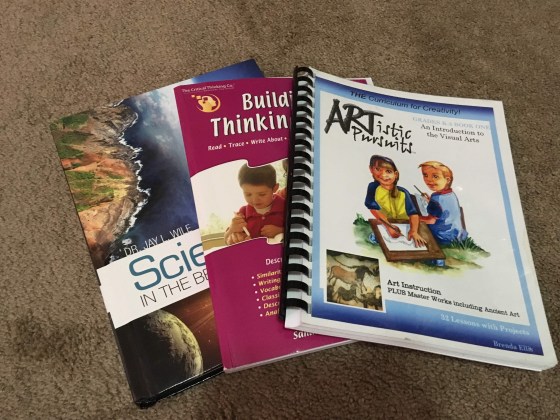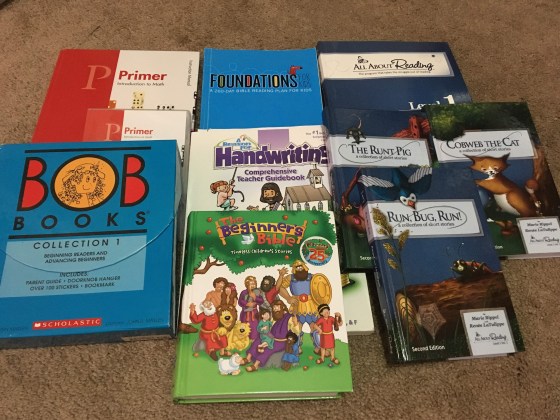 After yesterday’s rundown of our core curriculum choices, I wanted to share with you what electives we worked through over the past year!
After yesterday’s rundown of our core curriculum choices, I wanted to share with you what electives we worked through over the past year!
Science and Health
- In the Beginning by Berean Builders
- The World God Made by Christian Liberty Press
- Various Health and Safety Topics
The Berean Builders science series is written by Jay Wile, who wrote a lot of the Apologia books. In the Beginning organizes science topics by the first six days of creation and each “day” contains 15 lessons (example. The first day of creation contains 15 lessons on light, the second day of creation contains 15 lessons on water and air, etc). The last three lessons of each “day” are challenge lessons, that are appropriate for older or more advanced students. Each lesson contains 2-3 pages of reading, a simple experiment, and a few review questions separated by the age range of your student. The reading is a little more complex that what I would expect most kindergarteners to understand, so I modify the program by pre-reading the lesson and explaining it in simple terms. We then do the experiment, talk about the scientific principle we observed, and draw a picture in our science notebook.
The World God Made follows the days of creation as well, but is written for a much younger audience. It is a shorter program and the activities tend to be more arts and crafts based. However, it is a great supplement to our other program.
To teach health and safety, my husband and I are coming up with various topics that need to be addressed with our kids. These topics include bike safety, nutrition, handwashing, emergency preparedness, and various other skills. For each one, we mostly talk about the subject and try to find books at the library to reinforce the skills.
Science has been our “flounder” area. We tend to skip it more often than any other subject and I believe it is because of the academic writing of the Berean Builders book. I loved the curriculum; however, I feel like it is too advanced for this age range. This year we will be switching programs and I cannot wait to share how the change works out for us. I actually plan on keeping “In the Beginning” to use in a few years.
Social Studies
- DK Learning: Geography Workbook Kindergarten
- DK First Atlas
- Tennessee History For Kids: Kindergarten Lessons with Boxy
Ethan loves maps! Every time we visit a bookstore, we go straight to the atlas section! We have enjoyed working through the DK Learning Geography workbook. These are pretty basic black and white map skills books that start at the Preschool level. I also keep a few atlases to look up places when we talk about different countries and states in our reading.
In Tennessee, we have a website called Tennessee History for Kids. It is a good resource for our Tennessee History studies. They have a website full of ideas for field trips and they produce booklets for each grade level. Grades K-3 touch on all of the state social studies standards for those grades, while books for 4th grade and up cover all of the Tennessee history portion of the state social studies standards.
Logic
- Building Thinking Skills: Beginning
- Mind Benders Level 1
- Can You Find Me?
These workbooks from the Critical Thinking Company have been so much fun! Ethan refers to them as the “Play Books” and I use them a lot as a reward for finishing other work. We just finished up the Beginning book, and it has focused a lot on classifying colors, shapes, and types of lines. By far, our favorite activity is “Can You Find Me?,” which consists of a short poem with clues that allow your child to pick out which picture is being described from a list of 4 choices. We have used “Can You Find Me?” and “Beginning” without having to write in them, so you could use each book with multiple children. However, “Primary” looks like it will have more writing in it, so you may want to consider multiple copies for multiple kids.
Art
- Artisitic Pursuits K-3 Book 1
When I first started considering art programs, I knew I wanted something that was more “real art” than just cut and paste crafts. I also wanted something that covered a little bit of art appreciation/history. Artistic Pursuits fit the bill exactly. The supplies can be a little bit pricey because they recommend using higher quality materials. You can get around this slightly by getting cheaper materials or using coupons at craft stores. I asked for family members to give art supplies as birthday gifts and many did, so we ended up being gifted almost everything on the supply list. Each lesson in the book has a master piece of art to observe, discuss, and ask questions about. Then your child uses their imagination to create a unique work based off that master work. They work on sketching, painting, clay, and paper art in Book 1.
Misc.
- Let’s Learn to Cut by Spectrum Workbook
- Scissor Skills by Melissa and Doug
- Morning Adapted Work Binder by Mrs. D’s Corner (Teacherspayteachers.com)
I started to notice that I have not focused on fine motor skills much with Ethan! So we have added in a lot of toys that have smaller pieces, such as Legos, Lite Brite, and Beginner Snap Circuits. In addition, I started to give him paper to cut up into pieces. The “Let’s Learn to Cut” book and “Scissors Skills” sheets have been fun additions because they include lots of cutting activities and games while he works on those fine motor skills.
A cousin gave us a binder full of Velcro activities from teacherspayteachers.com that has been great for morning work! While I believe this was designed for a special needs classroom, I think it is appropriate for 3 year-olds through first or second grade.
What curriculum has worked in your homeschool this year?
 As we are finishing up a lot of our K5 Curriculum, I wanted to give a quick update of what we have ended up with for each core subject (Bible, Phonics, Math, Handwriting).
As we are finishing up a lot of our K5 Curriculum, I wanted to give a quick update of what we have ended up with for each core subject (Bible, Phonics, Math, Handwriting).